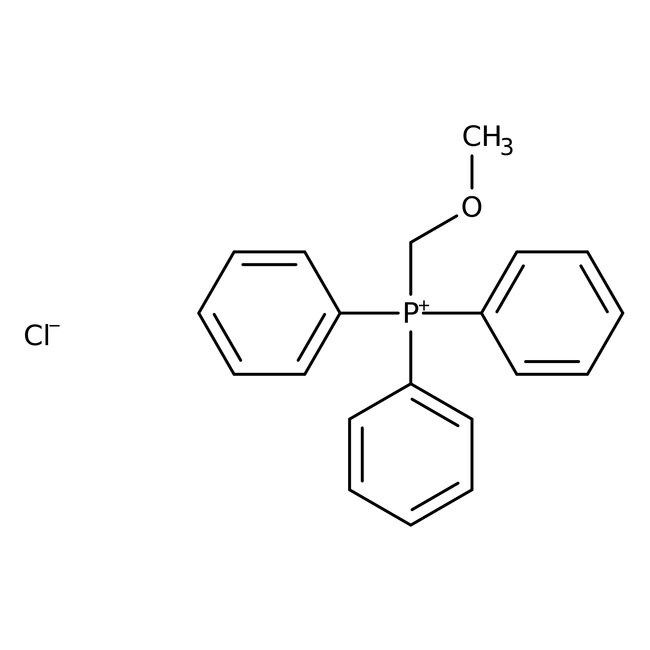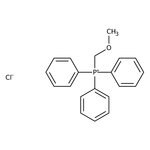Search Thermo Fisher Scientific
Thermo Scientific Chemicals
(Methoxymethyl)triphenylphosphonium chloride, 98+%, Thermo Scientific Chemicals
Catalog number: A14380.14
25 g, Each



Thermo Scientific Chemicals
(Methoxymethyl)triphenylphosphonium chloride, 98+%, Thermo Scientific Chemicals
Catalog number: A14380.14
25 g, Each
Quantity
Catalog number: A14380.14
also known as A14380-14
Price (USD)
Price: 64.60
Online price: 55.65
Your price:
Quantity
-
Chemical Identifiers
CAS
4009-98-7
IUPAC Name
(methoxymethyl)triphenylphosphanium chloride
Molecular Formula
C20H20ClOP
InChI Key
SJFNDMHZXCUXSA-UHFFFAOYSA-M
SMILES
[Cl-].COC[P+](C1=CC=CC=C1)(C1=CC=CC=C1)C1=CC=CC=C1
Specifications
Water Content (Karl Fischer Titration)
<2.0%
Appearance (Color)
White to very pale cream
Assay (Titration ex Chloride)
≥98.0 to ≤102.0% (dry wt basis)
Form
Powder or crystals or crystalline powder
Identification (FTIR)
Conforms
Description
(Methoxymethyl)triphenylphosphonium chloride is used as a phase transfer catalyst and in the synthesis of taxol-A fragment. It is widely used in the synthesis of pharmaceutical product cephalotaxine, which is used as an antiviral and antitumor agent.
This Thermo Scientific Chemicals brand product was originally part of the Alfa Aesar product portfolio. Some documentation and label information may refer to the legacy brand. The original Alfa Aesar product / item code or SKU reference has not changed as a part of the brand transition to Thermo Scientific Chemicals.
Applications
(Methoxymethyl)triphenylphosphonium chloride is used as a phase transfer catalyst and in the synthesis of taxol-A fragment. It is widely used in the synthesis of pharmaceutical product cephalotaxine, which is used as an antiviral and antitumor agent.
Solubility
Soluble in methanol and chloroform. It decomposes in water.
Notes
Hygroscopic . Incompatible with strong oxidizing agents.
(Methoxymethyl)triphenylphosphonium chloride is used as a phase transfer catalyst and in the synthesis of taxol-A fragment. It is widely used in the synthesis of pharmaceutical product cephalotaxine, which is used as an antiviral and antitumor agent.
Solubility
Soluble in methanol and chloroform. It decomposes in water.
Notes
Hygroscopic . Incompatible with strong oxidizing agents.
RUO – Research Use Only
Figures
Documents & Downloads
Certificates
Search by lot number or partial lot number
Frequently asked questions (FAQs)
Citations & References
Search citations by name, author, journal title or abstract text